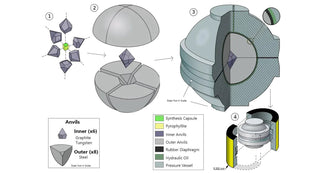
Lab Grown Diamonds
A COMPREHENSIVE EDUCATIONAL GUIDE
Embracing Sustainability
Opting for lab-grown diamonds presents a more environmentally conscious alternative. These diamonds are cultivated in controlled settings, bypassing the detrimental impacts associated with traditional mining practices. Unlike their natural counterparts, lab-grown diamonds boast a substantially reduced carbon footprint, aligning with the values of eco-conscious consumers and offering a more sustainable choice for those mindful of environmental impacts.
•‧•┈┈┈┈୨୧┈┈┈┈•‧•

What is Lab Grown Diamond?
Lab-grown diamonds, also known as "man-made" or "lab-created," replicate natural diamond formation in controlled lab environments. Composed of genuine carbon atoms arranged like naturally occurring diamonds, they share identical optical and chemical properties. This eco-friendly alternative offers sustainability without sacrificing quality or beauty.
By choosing lab-grown diamonds, consumers minimize the environmental impact of traditional mining practices while enjoying genuine diamond allure and brilliance.
Benefits of Lab Grown Diamond

Why Choose Lab Grown Diamond?
Lab-grown diamonds emerge as a compelling alternative to mined counterparts, boasting identical appearance, lower costs, and ethical sourcing. These lab-created gems offer several key advantages:
Firstly, they allow for the creation of rare colors, democratizing access to unique products.
Secondly, sourcing from reputable vendors ensures ethical practices and traceable origins, preventing exploitation of individuals or communities.
Lastly, meeting demand is more manageable through the use of HPHT and CVD processes, ensuring quality without resorting to harmful practices.
How Lab Grown Diamonds Made?
Little carbon seeds from pre-existing diamonds are used to generate lab-grown diamonds. Scientists use contemporary technology, such as high heat and pressure or a special deposition technique called chemical vapor deposition (CVD), to mimic the formation of diamonds naturally. Six to ten weeks are needed for the formation of a rough diamond. It is then cut, polished, and put in jewelry made of lab-created diamonds, such as bracelets, necklaces, or earrings.
To create lab-created diamonds, there are two primary methods:
1. High Pressure High Temperature (HPHT): This method mimics the conditions in which naturally occurring diamonds are formed in the earth. A large machine is fed a predetermined amount of carbon material, which is crushed at extreme temperatures between 1300 and 1600 degrees Celsius under pressure greater than 870,000 pounds per square inch to generate the lab diamond.
2. Chemical Vapor Deposition (CVD): CVD is the process of growing a seed diamond by heating hydrogen and carbon-containing gases inside a small vacuum chamber. A bigger diamond is produced when the gas molecules disintegrate and layers of crystallized carbon start to form around the seed at a specific temperature. Certain lab diamonds produced by CVD may undergo pressure and heat treatment after development.

Comparison GuideLAB GROWN DIAMOND VS. NATURAL DIAMOND

Price Of Lab Grown Diamond
Lab-grown diamonds are much more affordable than mined diamonds of comparable size and quality. They offer exceptional value for money as they are free from the significant markups typically applied to mined diamonds.
Historically, misleading advertisements have perpetuated the notion that larger diamonds symbolize greater love, a tactic the diamond industry has exploited to overcharge consumers. This belief persists, resulting in mined diamonds being marked up by at least 100% or more. In contrast, lab-grown diamonds come without such exorbitant markups. When purchasing a lab-grown diamond, you only pay for the creation process, making them a cost-effective and ethical choice.
Lab Grown Diamond FAQ's
IF YOU HAVE MORE QUESTIONS THAT WE DO NOT COVER BELOW THEN:

